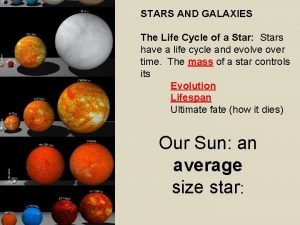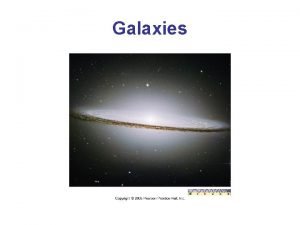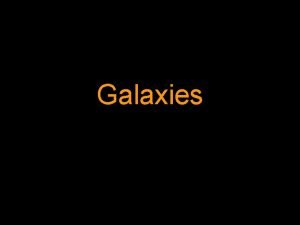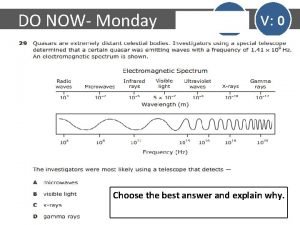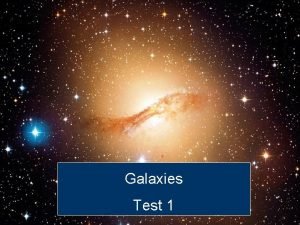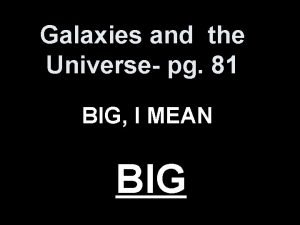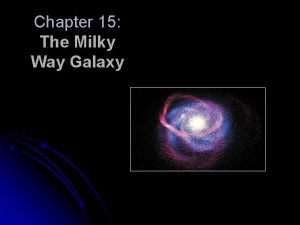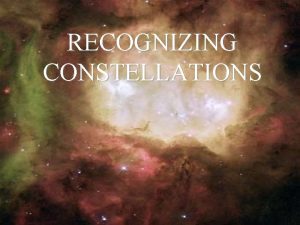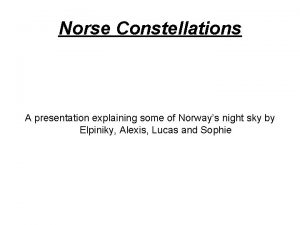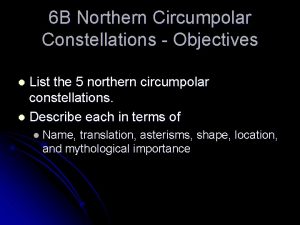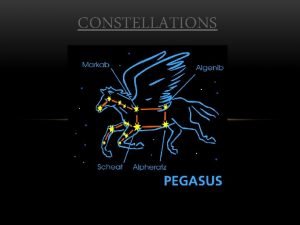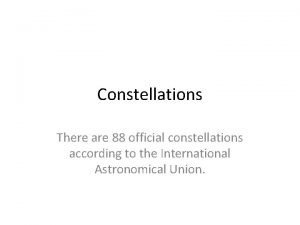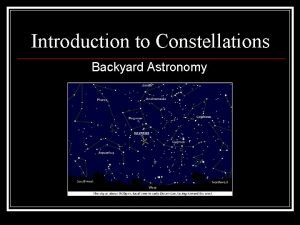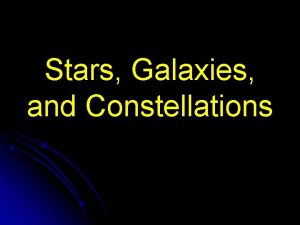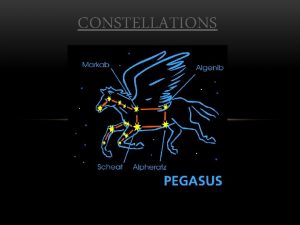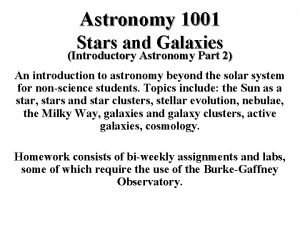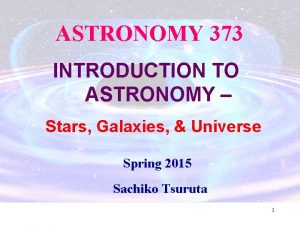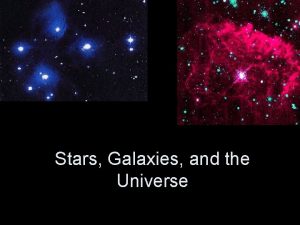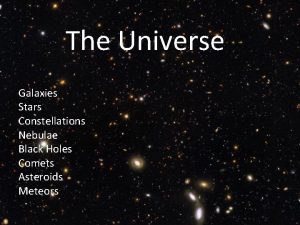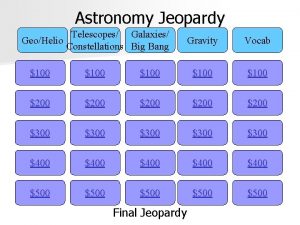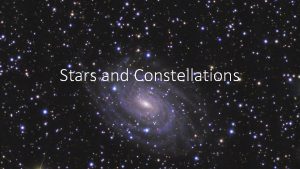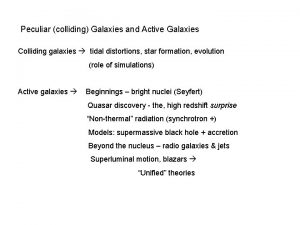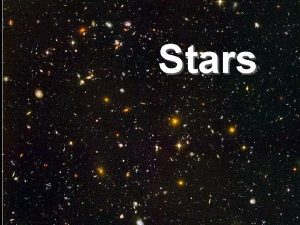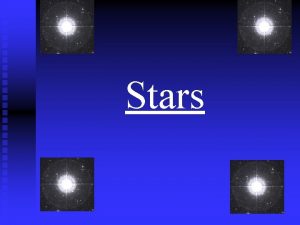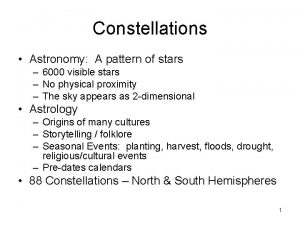EGS Astronomy Unit Stars constellations and the galaxies













































- Slides: 45

EGS Astronomy Unit

Stars, constellations, and the galaxies Big Bang Theory

Stars and Galaxies • Constellation – A pattern of stars that resemble real or imaginary things • Animals, heroes, gods, etc… – 88 named constellations, each with its own story



Stars and Galaxies • Constellations were used to help create the earliest calendars and for entertainment • Constellations are also used to divide the night sky into sectors to make it easier to find particular stars or planets




Stars and Galaxies • Galaxy- A large-scale group of stars bound together by gravity. – 100 billion stars – 100, 000 light-years in diameter • Speed of light – 300, 000 km/s or 9. 5 trillion km/year – 186, 000 miles/s or 5. 89 trillion miles/year

Stars and Galaxies • Types of Galaxies – Spiral- A bright central region surrounded by spiral arms made of younger stars that circle the center region – Elliptical- Spherical with no spiral arms; no young stars. – Irregular- No particular shape; may be formed as two galaxies collide



Stars and Galaxies • Milky Way Galaxy – Spiral galaxy – 100, 000 light-years in diameter – 2, 000 light-years thick near the center – Our sun is about 30, 000 light-years from the center in one of the spiral arms


Stars • A body of gases that give large amounts of energy in the form of light and heat. • Vary in chemical composition, color, temperature, size, mass, motion, distance from earth, and brightness.

Stars • Chemical Composition – Mostly Hydrogen and Helium with small amounts of carbon, nitrogen, and oxygen – Determined by using spectrum analysis • Every element has a specific spectrum that can be seen using a spectrometer which is capable of taking a source of light and breaking it down to individual wavelengths.

Stars


What is a wave? • A wave is a transfer of energy from one point to another via a traveling disturbance • A wave is characterized by its wavelength, frequency, and amplitude

Wave Properties • Mechanical waves must pass through a medium such as air, water, or solids • Electromagnetic waves do not require a medium and can move through a vacuum

Wavelength (λ) • Distance from successive crest to crest or trough to trough • Measured in meters

Frequency • Number of crests passing by per second • Measured in Hertz (Hz) defined to be one cycle per sec • Equal to the inverse of the amount of time it takes one wavelength to pass by

Amplitude • Maximum displacement of the wave • The amplitude will have different units depending on the type of wave • In a sketch of the wave, it is the distance from the middle of the wave to the peak

Wave Speed Traveling Waves move through space at a certain speed Where, v is the speed of the wave (m/s) λ is the wavelength in meters (m) f is the frequency in Hertz (cycle/s)

Wave Speed • Wave speed is constant for a given medium • The speed of a wave changes only when the wave moves from one medium to another or when certain properties of the medium are varied

Stars



Stars • Color and Temperature – The surface temperature of a star is indicated by its color • • • Blue-white Yellow Orange Red >30, 000 ˚C 7, 500 - 30, 000 ˚C 6, 000 - 7, 500 ˚C 5, 000 - 6, 000 ˚C 3, 500 - 5, 000 ˚C Less than 3, 500 ˚C

Stars • Size – Vary in size from 20 km in diameter to 1000 x larger than our sun – Our sun is 1, 392, 000 km in diameter • Mass – The sun is 330, 000 x more massive than earth – Stars can be 50 x greater or 1/50 smaller than our sun

Stars • Motion of Stars – Apparent motion • Motion of the star as seen by the human eye from earth • Appear to move westward in the sky around Polaris (the North Star) • Due to the rotation of the earth on its axis and its orbit around the sun

Stars • Motion of Stars – Actual motion • Rotate on its axis • Many revolve another star (binary stars) • Move away or toward the earth – Doppler Effect • Blue shift= moving toward earth • Red shift= moving away from earth


Stars • Distance from earth – Light-year: the distance light travels in one year – Speed of light = 300, 000 km/s SO a light-year = 9. 5 trillion km • The sun is 8 light-minutes away from earth • Next nearest star is Proxima Centauri which is 4. 2 light-years away

Stars • Distance from earth – Parallax • A change in position in relation to other stars over a six month period of time • The greater the change, the closer the star – How can we demonstrate Parallax?

Stars • Magnitude – A measure of the brightness of a star – Apparent Magnitude- the brightness as it appears from earth • Affected by distance from earth, size, and temperature – Absolute Magnitude- the true brightness if all stars were the same distance from earth


Evolution of a Star • A star’s life lasts billions of years!!! • Nebula- massive cloud of gas and dust – Increased pressure forms a protostar – Temps get hot enough that nuclear fusion begins • 2 H → 1 He – A star is born

Evolution of a Star • Main-sequence Star – Longest stage • Our sun is about 4. 5 billion years old, with that much life left to go • Third Stage – Hydrogen gone; Explosion; Helium fusion • Giant: 10 x greater in size than the sun • Supergiant: 100 x bigger than the sun

Evolution of a Star • Final Star Stage – Helium fusion ends – Gravity again causes remaining matter to collapse inward – Carbon from helium fusion burns forming a White Dwarf – If the white dwarf stops burning it dies and becomes a Dead Star or Black Dwarf

Evolution of a Star • Sometimes instead of fading away, a white dwarf explodes releasing matter and energy into space forming a Nova • In a supergiant star, after helium fusion is complete, the carbon can fuse into heavier elements which in turn fuse into iron forming a Supernova


Evolution of a Star • Neutron Star- After a supernova, the core may contract into a very small, dense ball of neutrons • Black Holes- matter is compacted so tightly that the gravitational force is greater than the speed of light. May be found at the center of many galaxies.

Evolution of a Star • Formation of Neutron Stars and Black Holes • How do we demonstrate a black hole?
 What waves are produced by stars and galaxies
What waves are produced by stars and galaxies Learning astronomy by doing astronomy
Learning astronomy by doing astronomy Learning astronomy by doing astronomy activity 7 answers
Learning astronomy by doing astronomy activity 7 answers Learning astronomy by doing astronomy
Learning astronomy by doing astronomy There are millions of stars in
There are millions of stars in Egs accounting
Egs accounting Apec environmental goods
Apec environmental goods Evaluation schreiben beispiel
Evaluation schreiben beispiel Kaic calculator
Kaic calculator Chapter 30 galaxies and the universe
Chapter 30 galaxies and the universe Spiral irregular and elliptical galaxies
Spiral irregular and elliptical galaxies Life cycle of galaxies
Life cycle of galaxies Facts about elliptical galaxies
Facts about elliptical galaxies Galaxies
Galaxies The pity relation for an adiabatic expansion is
The pity relation for an adiabatic expansion is Milky way galaxy shape
Milky way galaxy shape Types of galaxies
Types of galaxies Brainpop galaxies quiz answers
Brainpop galaxies quiz answers 4 types of galaxies
4 types of galaxies How are galaxies classified? *
How are galaxies classified? * Tipus de galaxies
Tipus de galaxies Type of galaxy
Type of galaxy Evolution of galaxies
Evolution of galaxies Universepg
Universepg Galaxies lesson plan
Galaxies lesson plan Year round constellations
Year round constellations Thiazi's eyes constellation
Thiazi's eyes constellation Les constellations les plus connues
Les constellations les plus connues Yujin constellations
Yujin constellations Cetus constellation myth
Cetus constellation myth Findpkjobs.com
Findpkjobs.com What are constellations
What are constellations Pretestp
Pretestp What are constellations?
What are constellations? Constellations
Constellations 88 official constellations
88 official constellations Are constellations capitalized
Are constellations capitalized An autumn constellation the goat fish
An autumn constellation the goat fish Five circumpolar constellations
Five circumpolar constellations How to wear a jrotc uniform
How to wear a jrotc uniform Unit 10, unit 10 review tests, unit 10 general test
Unit 10, unit 10 review tests, unit 10 general test Astronomy questions and answers multiple choice
Astronomy questions and answers multiple choice Michigan state university physics
Michigan state university physics Hát kết hợp bộ gõ cơ thể
Hát kết hợp bộ gõ cơ thể Bổ thể
Bổ thể











